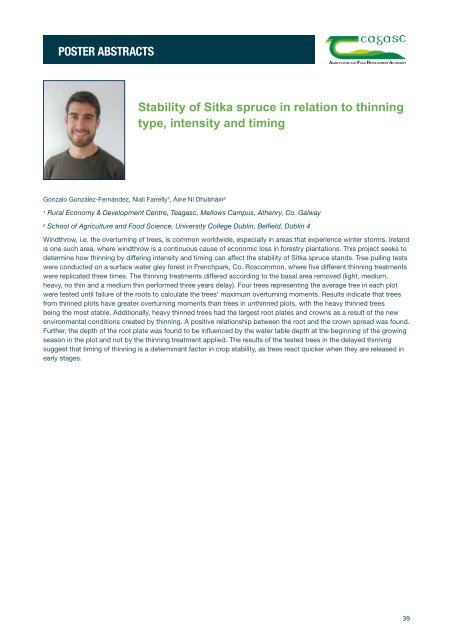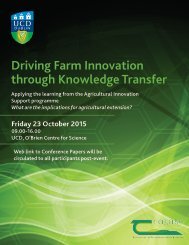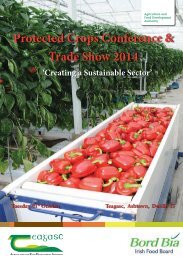FellowshipS Seminar 2016
2fFF9y9
2fFF9y9
Create successful ePaper yourself
Turn your PDF publications into a flip-book with our unique Google optimized e-Paper software.
Poster ABSTRACTS<br />
Stability of Sitka spruce in relation to thinning<br />
type, intensity and timing<br />
Gonzalo González-Fernández, Niall Farrelly¹, Áine Ní Dhubháin²<br />
1 Rural Economy & Development Centre, Teagasc, Mellows Campus, Athenry, Co. Galway<br />
2 School of Agriculture and Food Science, University College Dublin, Belfield, Dublin 4<br />
Windthrow, i.e. the overturning of trees, is common worldwide, especially in areas that experience winter storms. Ireland<br />
is one such area, where windthrow is a continuous cause of economic loss in forestry plantations. This project seeks to<br />
determine how thinning by differing intensity and timing can affect the stability of Sitka spruce stands. Tree pulling tests<br />
were conducted on a surface water gley forest in Frenchpark, Co. Roscommon, where five different thinning treatments<br />
were replicated three times. The thinning treatments differed according to the basal area removed (light, medium,<br />
heavy, no thin and a medium thin performed three years delay). Four trees representing the average tree in each plot<br />
were tested until failure of the roots to calculate the trees’ maximum overturning moments. Results indicate that trees<br />
from thinned plots have greater overturning moments than trees in unthinned plots, with the heavy thinned trees<br />
being the most stable. Additionally, heavy thinned trees had the largest root plates and crowns as a result of the new<br />
environmental conditions created by thinning. A positive relationship between the root and the crown spread was found.<br />
Further, the depth of the root plate was found to be influenced by the water table depth at the beginning of the growing<br />
season in the plot and not by the thinning treatment applied. The results of the tested trees in the delayed thinning<br />
suggest that timing of thinning is a determinant factor in crop stability, as trees react quicker when they are released in<br />
early stages.<br />
39




